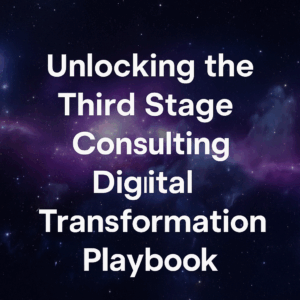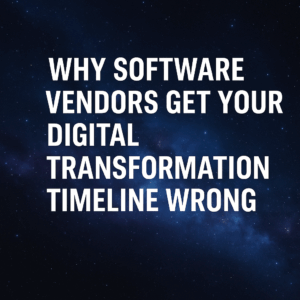Digital transformation leaders occasionally require a moment akin to Tony Robbins’ motivational speeches. They seek that essential push to ensure their success. The question remains: what would Tony Robbins or another motivational speaker impart to invigorate and motivate you? That is the topic of discussion for today.

As digital transformation consultants at Third Stage, one of our primary responsibilities is to inspire both project team members and organizational leaders to achieve success. It’s akin to playing a role similar to that of Tony Robbins by offering the necessary motivational speech and pep talk that organizations require. While I may not possess the stature or energy of Tony Robbins, I am committed to energizing you and your team to ensure success in your projects. For those unfamiliar with Tony Robbins, think of other motivational figures like Oprah Winfrey or Deepak Chopra. Remember, this is a broad motivational discourse aimed at enhancing your success in your transformation journey.
Table of Contents
ToggleThis Is Your Project
The primary motivational guidance I can offer emphasizes the fact that this is your project. It doesn’t belong to your software vendor, your system integrator, or any external consultants; it is distinctly yours. As the organization and team that will experience the outcomes of this digital transformation, it is imperative to treat the project with the importance it warrants. Instead of outsourcing or delegating the project to peripheral members of the organization, you should embrace ownership and maintain control. This signifies playing an active role: making key decisions, ensuring the project remains on course, and verifying that the overarching strategy and deployment plan align with the organization’s needs and priorities. In essence, this project is uniquely yours, and it is vital to acknowledge and act upon that ownership.
Your Business Is Unique
The subsequent motivational insight I offer underscores the uniqueness of your business. Often, the software industry promotes the idea of universal best practices, pre-configured solutions, and “one-size-fits-all” approaches. While these concepts might serve as compelling sales pitches, they often diverge from the practical realities businesses face. Your organization stands out not only within its industry but also in its distinctive methodologies and practices, many of which have been adopted for specific strategic reasons.
Certainly, there may be processes within your business that could benefit from modification or even elimination if they lack strategic rationale. However, many of your existing practices constitute a core competitive advantage. They differentiate you in the marketplace, setting you apart from competitors. It would be detrimental to dilute these advantages simply because a software vendor suggests they possess a superior solution.
The challenge lies in leveraging technology to enhance processes without undermining your inherent competitive strengths. The goal is to utilize technology to augment these advantages, not to transform or discard them entirely. Regardless of the prevailing industry narrative, it’s crucial to acknowledge the distinctiveness of your business and determine which aspects to preserve and enhance.
Less Technology, More Change Management
Humans inherently exhibit certain flaws. One such flaw is the inclination towards tangible objects—things we can see, touch, or feel. Conversely, we often neglect or dismiss intangible elements. This tendency is evident in digital transformations. There’s a general inclination to emphasize the tangible aspect of technology—devices we can use, workflows we can execute, and transactions we can complete. However, the intangible realm of human behavior and change management, which is less tangible and harder to define, often gets sidelined. This oversight is problematic, as successful digital transformations pivot on these very human-centric aspects more than the technological ones.
The paramount advice, therefore, is to emphasize what truly drives project success: change management. This element stands as a pivotal success factor. When faced with the choice between prioritizing technology or change management, it is change management that will more swiftly guide you towards success.
Moreover, it’s essential to recognize that your internal team holds more significance than any external vendor. It’s concerning to observe organizations prioritizing their software vendors or technical implementation partners over their own employees. While vendors and integrators may adeptly navigate organizational politics for their own gain, the onus is on the organization to prioritize its internal stakeholders.
Another crucial aspect to consider is capability building. Empower your employees to play an active role in the digital transformation, even if it pushes them beyond their comfort zones. Outsourcing to experts can inadvertently induce a sense of dependence within an organization. However, it’s vital to ensure that your team is equipped with the necessary capabilities. After all, post-transformation, it is your team that will bear the results, whether positive or negative. Therefore, prioritize and value your internal team over any third-party or external consulting entity.

If You Don’t Like It, Change It
Digital transformations invariably encounter challenges, pitfalls, and risks. The question isn’t if these will arise, but rather how an organization will respond when they do. Often, organizations may neglect these pitfalls or receive reassurances from software vendors that all is well. However, taking ownership of these challenges is essential to ensure the project remains on track.
One of the vital competencies for leaders and project teams is discerning when to pivot and when to make course corrections. This might be contrary to the desires of the software vendor, system integrator, reseller, or technical implementation partner. Nevertheless, since the project is the responsibility of the organization, it is imperative to keep it aligned with the desired outcomes. If there’s an excessive expenditure on resources, consider scaling back. If the project’s pace is too swift and outstripping the organization’s ability to adapt, then it may be prudent to adjust the project’s direction and pace. Should there be insufficient internal resources or a lack of alignment among the leadership team on the project’s objectives, slowing or even pausing the project might be necessary.
While such decisions might not always align with the preferences of third-party stakeholders, they might be in the best interest of the organization. Making these informed, bold choices is integral to the success of a digital transformation.
Digital Transformations Are Difficult But Not Impossible
Digital transformations are inherently challenging. Undertaking such a transition as an organization will inevitably present obstacles. Yet, it’s essential to understand that while the journey is challenging, it is not insurmountable. Despite alarming statistics suggesting high failure rates for digital transformations, success is attainable.
For the purpose of this discussion, acknowledging the inherent difficulty but also recognizing the possibility of success is pivotal. Navigating through the plethora of information about project failures and challenges can be daunting. However, success doesn’t hinge on an overly complex formula. While the journey is arduous and full of challenges, there are actionable steps that can lead to successful outcomes. The foundation of success lies within the project team, the leadership team, and the broader organization. Their collective efforts, commitment, and resolve will be the driving force behind a successful digital transformation.

I would enjoy brainstorming ideas with you if you are looking to strategize an upcoming transformation or are looking at selecting an ERP system, so please feel free to contact me at eric.kimberling@thirdstage-consulting.com. I am happy to be a sounding board as you continue your digital transformation journey.





